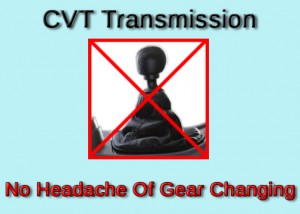In general, cars have mainly three types of transmission systems namely, manual, automatic (AT) and automatic manual transmission (AMT). But, there is another alternative for conventional automatic transmission system called continuously variable transmission (CVT) (also known as a single-speed transmission, variable pulley transmission or stepless transmission) which does not have set of gears that are usually used to transmit power from engine to the wheels. Commonly, CVT cars are pulley based systems but some manufacturers also use toroidal CVTs.
Working of pulley type CVT:
 CVT systems does not have a complex gear and they do not involve any type of tooth alignment problems. CVT just has two variable diameter pulleys each shaped like a pair of cones opposing each other, with a metal belt or chain running between them. Driving pulley is connected to the crank shaft of the engine and the driven pulley is connected to the drive shaft. The belt of the system rides between the two cones connecting the two pulleys. When one pulley increases its diameter, the other pulley decreases its diameter by keeping belt tight. If the pitch radius is large on the driving pulley and smaller on the driven pulley, then driven pulley rotates with high speed and if the pitch radius is large on the driven pulley and smaller on the driving pulley, the driven pulley will rotate with low speed. In CVT infinite number of gear ratios are achieved by varying radius of the pulleys, but the highest and lowest gear ratio is close to the extreme gear ratios in the AT system.
CVT systems does not have a complex gear and they do not involve any type of tooth alignment problems. CVT just has two variable diameter pulleys each shaped like a pair of cones opposing each other, with a metal belt or chain running between them. Driving pulley is connected to the crank shaft of the engine and the driven pulley is connected to the drive shaft. The belt of the system rides between the two cones connecting the two pulleys. When one pulley increases its diameter, the other pulley decreases its diameter by keeping belt tight. If the pitch radius is large on the driving pulley and smaller on the driven pulley, then driven pulley rotates with high speed and if the pitch radius is large on the driven pulley and smaller on the driving pulley, the driven pulley will rotate with low speed. In CVT infinite number of gear ratios are achieved by varying radius of the pulleys, but the highest and lowest gear ratio is close to the extreme gear ratios in the AT system.
Advantages of the CVT systems:
- In CVT, engine does not develop power constantly at all the time. They have specific speed where horsepower (speed power), fuel efficiency and torque (pulling power) are maximum.
- CVT drive is smooth, due to absence of gears in its system. In CVT the person sitting inside the car will not hear or feel the transmission shift.
- CVT delivers quicker acceleration when compared to automatic transmission or manual transmission and delivers good fuel economy.
- Cost of the car is less due to less parts in the transmission system.
- Fuel efficiency for a pulley based CVT is about 88% while in case of AT for a gear system it is 86% and in toroidal based CVT system the efficiency is as high as 93%.
CVT car models so far launched in India –
- Honda Jazz CVT (petrol)
- Honda City VX CVT (petrol)
- Nissan Micra XL CVT (petrol)
- Maruti Suzuki Baleno Delta CVT (petrol)
